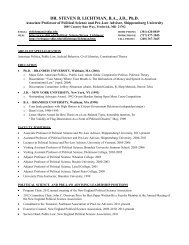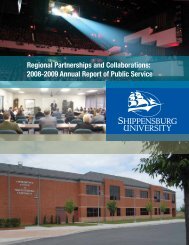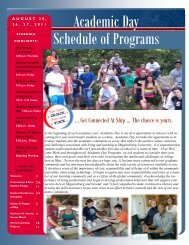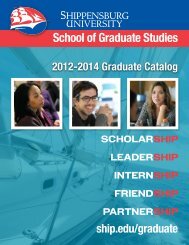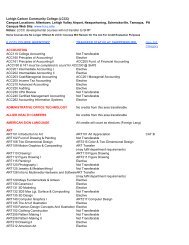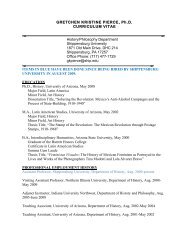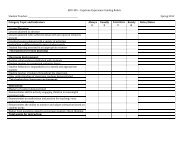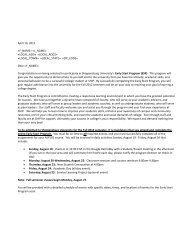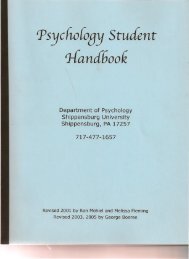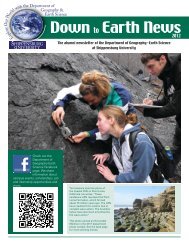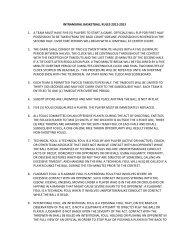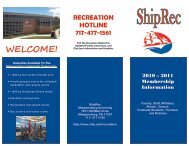5Message in a BottleC h a r l e s Fi s h m a nF a s t Co m p a n yThe largest bottled-water factory in North Americais located on the outskirts of Hollis, Maine. In theback of the plant stretches the staging area for finishedproduct: twenty four million bottles of Poland Springwater. As far as the eye can see, there are doublestackedpallets packed with half-pint bottles, half-liters,liters, “Aquapods” for school lunches, and 2.5-gallonjugs for the refrigerator.Really, it is a lake of Poland Spring water,conveniently celled off in plastic, extending acrosssix acres, eight feet high. A week ago, the lake wasstill underground; within five days, it will all be gone,to supermarkets and convenience stores across theNortheast, replaced by another lake’s worth of bottles.Looking at the piles of water, you can have only onethought: Americans sure are thirsty.Bottled water has become the indispensable propin our lives and our culture. It starts the day in lunchboxes; it goes to every meeting, lecture hall, and soccermatch; it’s in our cubicles at work; in the cup holder ofthe treadmill at the gym; and it’s rattling around halffinishedon the floor of every minivan in America. FijiWater shows up on the ABC show Brothers & Sisters;Poland Spring cameos routinely on NBC’s The Office.Every hotel room offers bottled water for sale, alongsidethe increasingly ignored ice bucket and drinkingglasses. At Whole Foods, the upscale emporium of theorganic and exotic, bottled water is the number-oneitem by units sold.Thirty years ago, bottled water barely existed as abusiness in the United States. Last year, we spent moreon Poland Spring, Fiji Water, Evian, Aquafina, andDasani than we spent on iPods or movie tickets—$15billion. It will be $16 billion this year.Bottled water is the food phenomenon of ourtimes. We—a generation raised on tap water and waterfountains—drink a billion bottles of water a week, andwe’re raising a generation that views tap water withdisdain and water fountains with suspicion. We’ve cometo pay good money—two or three or four times the costof gasoline—for a product we have always gotten, andcan still get, for free, from taps in our homes.When we buy a bottle of water, what we’re oftenbuying is the bottle itself, as much as the water. We’rebuying the convenience—a bottle at the 7-Eleven isn’tthe same product as tap water, any more than a cup ofcoffee at Starbucks is the same as a cup of coffee fromthe Krups machine on your kitchen counter. And we’rebuying the artful story the water companies tell usabout the water: where it comes from, how healthy itis, what it says about us. Surely among the choices wecan make, bottled water isn’t just good, it’s positivelyvirtuous.Except for this: bottled water is often simply anindulgence, and despite the stories we tell ourselves, itis not a benign indulgence. We’re moving one billionbottles of water around a week in ships, trains, andtrucks in the United States alone. That’s a weeklyconvoy equivalent to 37,800 eighteen-wheelersdelivering water. (Water weighs 8 1/3 pounds a gallon.It’s so heavy you can’t fill an eighteen-wheeler withbottled water—you have to leave empty space.)Meanwhile, one out of six people in the world has nodependable, safe drinking water. The global economyhas contrived to deny the most fundamental elementof life to one billion people, while delivering to us anarray of water “varieties” from around the globe, notone of which we actually need. That tension is onlycomplicated by the fact that if we suddenly decided notto purchase the lake of Poland Spring water in Hollis,Maine, none of that water would find its way to peoplewho really are thirsty.A chilled plastic bottle of water in the conveniencestorecooler is the perfect symbol of this moment inAmerican commerce and culture. It acknowledgesour demand for instant gratification, our vanity, ourtoken concern for health. Its packaging and transportdepend entirely on cheap fossil fuel. Yes, it’s just abottle of water—modest compared with the indulgenceof driving a Hummer. But when a whole industrygrows up around supplying us with something we don’tCharles Fishman is an award-winning senior writer at Fast Company. As an investigative journalist, he has reported ontopics as diverse as Wal-Mart, bomb factories, and NASA. In 2007, he did a story on bottled water that changed theway he thought about water. Based on research for that article, he is working on a book exploring how water affectslife around the world. He is the author of the best seller, The Wal-Mart Effect.
6 PROTEUS: A Journal of Ideasneed—when a whole industry is built on the packagingand the presentation—it’s worth asking how thathappened, and what the impact is. And if you do ask, ifyou trace both the water and the business back to wherethey came from, you find a story more complicated,more bemusing, and ultimately more sobering than thebottles we tote everywhere suggest.In the town of San Pellegrino Terme, Italy, forexample, is a spigot that runs all the time, providingSan Pellegrino water free to the local citizens—exceptthe free Pellegrino has no bubbles. Pellegrino trucks inthe bubbles for the bottling plant. The man who firstbrought bottled water to the United States famouslyfailed an impromptu taste test involving his ownproduct. In Maine, there is a marble temple to honorour passion for bottled water.And in Fiji, a state-of-the-art factory spins out morethan a million bottles a day of the hippest bottled wateron the U.S. market today, while more than half thepeople in Fiji do not have safe, reliable drinking water.Which means it is easier for the typical American inBeverly Hills or Baltimore to get a drink of safe, pure,refreshing Fiji water than it is for most people in Fiji.At the Peninsula hotel in Beverly Hills, where therooms start at $500 a night and the guest next doormight well be an Oscar winner, the minibar in all 196rooms contains six bottles of Fiji Water. Before FijiWater displaced Evian, Diet Coke was the numberone-sellingminibar item. Now, says Christian Boyens,the Peninsula’s elegant director of food and beverage,“the one liter of Fiji Water is number one. Diet Cokeis number two. And the 500-milliliter bottle of Fiji isnumber three.”Being the water in the Peninsula minibar is sodesirable—not just for the money to be made, butfor the exposure with the Peninsula’s clientele—thatBoyens gets a sales call a week from a company tryingto dislodge Fiji.Boyens, who has an MBA from Cornell, used to beindifferent to water. Not anymore. His restaurants andbars carry 20 different waters. “Sometimes a guest willask for Poland Spring, and you can’t get Poland Springin California,” he says. So what does he do? “We’ll callthe Peninsula in New York and have them FedEx outa case.“I thought water was water. But our customers knowwhat they want.”The marketing of bottled water is subtle comparedwith the marketing of, say, soft drinks or beer. Thepoint of Fiji Water in the minibar at the Peninsula,or at the center of the table in a white-tableclothrestaurant, is that guests will try it, love it, and buy it ata store the next time they see it.Which isn’t difficult, because the water aisle in asuburban supermarket typically stocks a dozen brandsof water—not including those enhanced with flavors orvitamins or, yes, oxygen. In 1976, the average Americandrank 1.6 gallons of bottled water a year, according toBeverage Marketing Corp. Last year, we each drank28.3 gallons of bottled water—18 half-liter bottles amonth. We drink more bottled water than milk, orcoffee, or beer. Only carbonated soft drinks are morepopular than bottled water, at 52.9 gallons annually.No one has experienced this transformation moreprofoundly than Kim Jeffery. Jeffery began his careerin the water business in the Midwest in 1978, sellingPerrier (“People didn’t know whether to put it in theirlawn mower or drink it,” he says). Now he’s the CEOof Nestlé Waters North America, in charge of U.S.sales of Perrier, San Pellegrino, Poland Spring, anda portfolio of other regional natural spring waters.Combined, his brands will sell some $4.5 billion worthof water this year (generating roughly $500 millionin pretax profit). Jeffery insists that unlike the sodabusiness, which is stoked by imaginative TV andmarketing campaigns, the mainstream water business is,quite simply, “a force of nature.”“The entire bottled-water business today is half thesize of the carbonated beverage industry,” says Jeffery,“but our marketing budget is 15 percent of what theyspend. When you put a bottle of water in that cold box,it’s the most thirst-quenching beverage there is. There’snothing in it that’s not good for you. People just knowthat intuitively.“A lot of people tell me, you guys have done somegreat marketing to get customers to pay for water,”Jeffery says. “But we aren’t that smart. We had to have ahell of a lot of help from the consumer.”Still, we needed help learning to drink bottled water.For that, we can thank the French.Gustave Leven was the chairman of Source Perrierwhen he approached an American named Bruce Nevinsin 1976. Nevins was working for the athletic-wearcompany Pony. Leven was a major Pony investor. “Hewanted me to consider the water business in the U.S.,”Nevins says. “I was a bit reluctant.” Back then, theAmerican water industry was small and fusty, built onhome and office delivery of big bottles and grocery salesof gallon jugs.Nevins looked out across 1970s America, though,and had an epiphany: Perrier wasn’t just water. It wasa beverage. The opportunity was in persuading peopleto drink Perrier when they would otherwise have had acocktail or a Coke. Americans were already drinking 30gallons of soft drinks each a year, and the three-martinilunch was increasingly viewed as a problem. Nevins sawa niche.From the start, Nevins pioneered a threepartstrategy. First, he connected bottled water toexclusivity: In 1977, just before Perrier’s U.S. launch,he flew 60 journalists to France to visit “the source”where Perrier bubbled out of the ground. He connectedPerrier to health, sponsoring the New York CityMarathon, just as long-distance running was exploding



